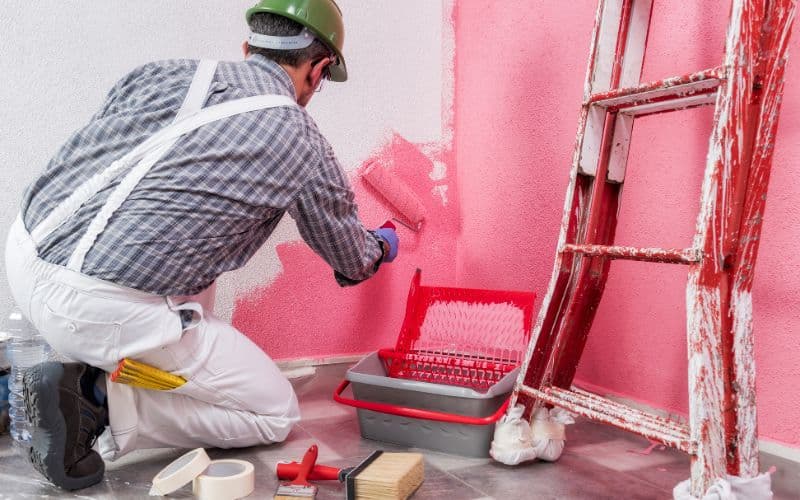What is The Best Way To Paint Over Painted Walls
Our expert team of skilled painters and decorators is here to bring new life to your home or business.
If you’re considering giving your home a fresh look, painting over old paint can be an excellent way to achieve a transformative effect without significant renovations. However, to ensure a flawless and long-lasting result, knowing the best way to approach this task is essential. In this post, we’ll explore valuable tips and insights on effectively painting over-painted walls. Whether you’re looking to refresh the colors or update the style of your interiors, the expertise of Star Painter and Decorator in Coventry can guide you through the process, ensuring a professional finish that revitalizes your living spaces. Let’s delve into the best practices for painting over painted walls to elevate the ambience of your home.

Evaluating the State of the Existing Paint
Several factors must be evaluated when considering whether it is suitable to paint over already painted walls. Firstly, the state of the existing paint should be examined. If the walls have a single coat of paint that is still in good condition, it may be possible to proceed with painting over it. However, if the paint is peeling, cracked, or has other visible signs of damage, it is recommended to remove the old paint before applying a new coat.
Additionally, any holes or cracks in the walls should be addressed before painting to ensure a smooth and even surface. Following proper preparation techniques, such as cleaning the walls and applying a primer, is essential to prevent the new paint from peeling or not adhering properly. Painting over already painted walls can be suitable if the desired paint change is not drastic and the walls are in good condition. However, if the walls have been painted multiple times and show signs of extensive wear or damage, it is advisable to take the necessary steps to restore the wall before proceeding with painting.
Preparing Your Walls for a Fresh Coat
Preparing your walls for a fresh coat of paint is essential to ensure a smooth and professional finish. Before you begin painting, it is necessary to sand and fill any imperfections in your walls. Start by thoroughly cleaning the surface you are painting with a damp cloth, removing any dirt or grime. Next, use 200-250 grit paper to sand any peeling paint, flaking paint, or rough wall areas. This will help create a smooth surface for the new coat of paint.
Fill any holes and cracks in the drywall with a filler, such as a spackle or joint compound, and allow it to dry thoroughly. Once the filler has dried, sand the filled areas with 200-250 grit paper before priming. Applying a layer of primer to tint will help seal the stuffing and keep it in place. After priming, allow the primer to dry thoroughly before applying the new coat of paint. Following these steps and adequately prepping your walls is essential to avoid a patchy look or difficulties when painting over old paint. You will create a smooth and professional finish for your walls by sanding, filling, and priming before painting.
Choosing the Primer and the Right Type of Paint
When choosing the right type of paint over old paint, it is crucial to consider a few key factors. Firstly, it is essential to use a primer as this will ensure better coverage and adhesion of the new paint. The primer will also provide a sealed surface for the fresh paint to stick to, preventing any bleeding of the old colour through the new coat. Additionally, using sound, oil-based paint is recommended, as this type of paint tends to adhere better to surfaces that are difficult to paint, such as glossy or previously painted walls.
However, if the old paint is colored, it is advisable to use sugar soap to clean the surface before applying a coat of primer. This will remove dirt or grease and ensure a smooth finish. If the color change is drastic, using a primer or basic white paint before the final color is also an excellent method to provide the proper coverage. Before starting painting, it is essential to prepare the paintwork by wiping it down with a damp cloth.
Once the surface is clean, applying an emulsion for the first coat is recommended, as this will provide a good base for the final color. Using multiple coats to stop the previous color from showing through is also important. For any filled areas, it is essential to sand and prime the served areas before painting over them. Choosing the right type of paint and adequately preparing the surface are crucial steps in achieving a successful paint job.
Repainting with Precision: Techniques for Successfully Painting Over Old Paint
When repainting a wall, it is essential to employ techniques that ensure precision and success. One crucial aspect is adequately covering the old color. Before painting, it is advisable to scrape off any loose or peeling paint, as paint applied over old, flaking layers will not adhere properly. Providing a clean and smooth surface for the new paint to adhere to is essential. To achieve the desired result, applying at least two coats of paint is often necessary.
However, in some cases, depending on the color change or the existing wall, more coats may be required. An excellent method to achieve a seamless paint layer is to start with a primer or base coat, followed by one coat of paint in the desired color. Two coats of colored paint are generally sufficient but may require additional coats if the existing wall color is particularly strong or vibrant. It is essential to choose a high-quality paint for all the coats, preferably a latex-based paint for interior walls, as it provides better coverage and dries quickly. Lastly, while repainting old paint can be a time-consuming process, a professional and impressive result can be achieved with careful attention to detail and the use of appropriate techniques.
Expert Tips for Achieving a Professional Finish
To achieve a professional finish when painting interior walls, it is essential to follow expert tips that can help ensure a flawless outcome. Firstly, if the walls have already been painted, it is recommended to remove the old paint before applying a new coat. This is suitable if the paint change is drastic, as the fresh paint will not adhere properly to the old surface. Using a sander is a practical approach to removing the old paint. Before starting the painting process, it is essential to thoroughly sand the whole wall to avoid any blemishes or unevenness.
Additionally, if you are painting over a dark color or a wall that appears a little worse for wear, it is advisable to prime the surface before applying the new coat. Priming can help create a smooth and even base for the paint, resulting in a more professional finish. Another option is using high-quality paint that offers better coverage and durability. Furthermore, it is crucial to remember to wipe away any dust or debris from the walls before painting, as this can result in a less smooth finish. Following these expert tips makes achieving a professional finish when painting interior walls more attainable.
Conclusion
In conclusion, knowing the best way to paint over painted walls is essential to achieve a successful and long-lasting result. Taking the time to assess the existing paint’s condition, properly prepare the walls, and choose the right type of paint ensures a smooth and professional finish. Whether you’re looking to refresh the color or update the look of your space, following the recommended steps for painting over old walls will lead to a successful transformation. With the proper techniques and attention to detail, you can confidently repaint the already-painted barriers, giving your home a fresh and revitalized appearance.
Get In Touch
Book Your Appointment
Contact Us
- +44 7479 277887
- [email protected]
- Coventry, United Kingdom
- Monday to Saturday 8 AM to 5 PM
- Get Directions




